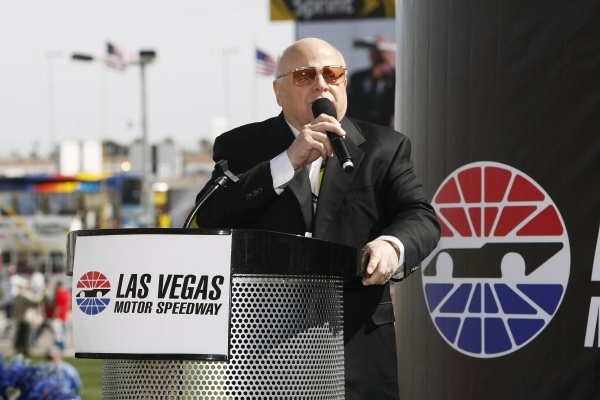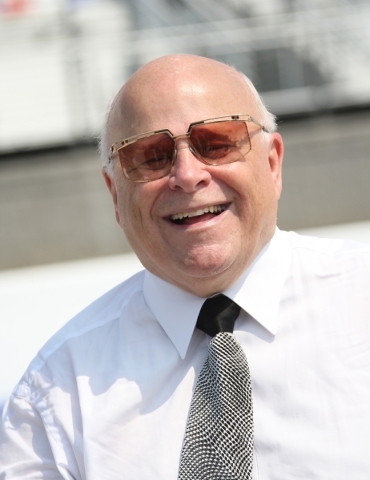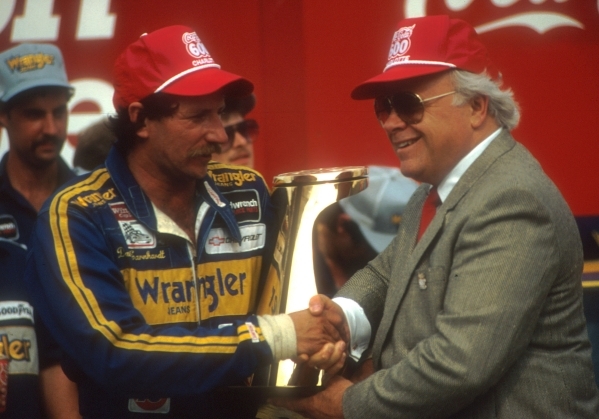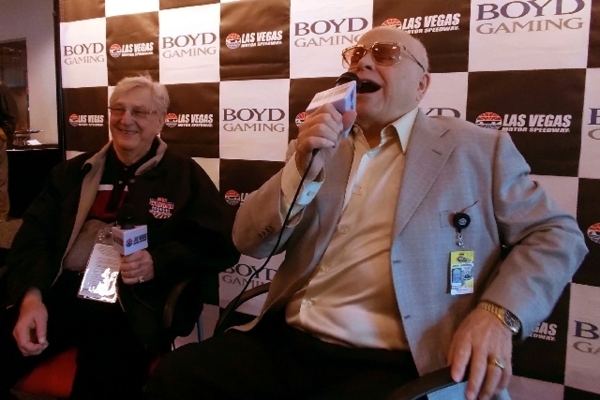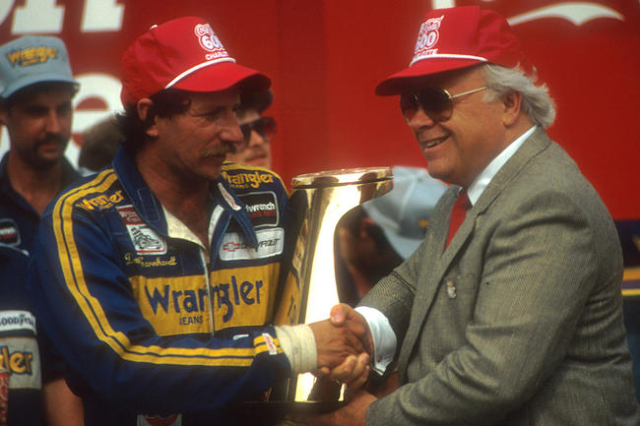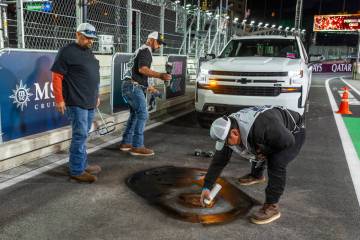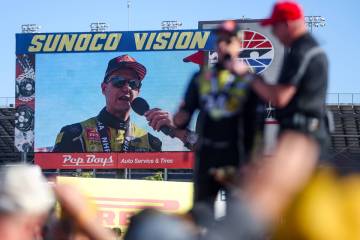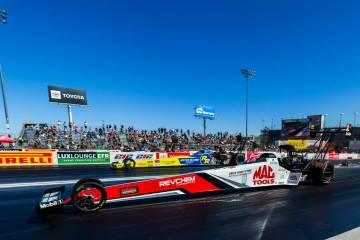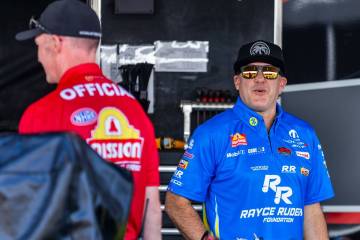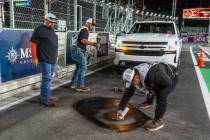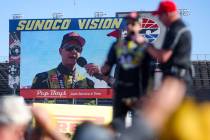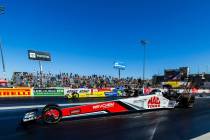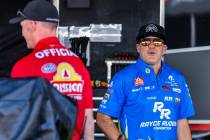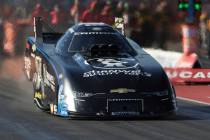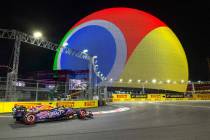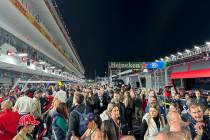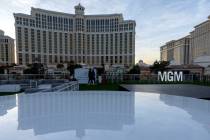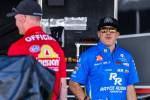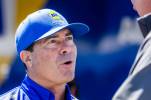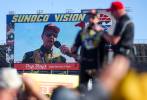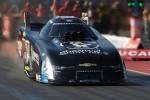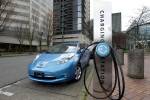LVMS owner Bruton Smith enters NASCAR Hall of Fame
They'll be telling good ol' boy stories about Jerry Cook and Bobby Isaac and Terry Labonte and Curtis Turner at the Charlotte (N.C.) Convention Center, because tonight is NASCAR Hall of Fame night, and those are the lead foots being inducted.
They'll also be telling O. Bruton Smith stories, though they probably will just drop the O. (It stands for Ollen.) Bruton Smith owns Las Vegas Motor Speedway and seven other tracks, and a bunch of car dealerships, and some other stuff, including a racing radio network. The 88-year-old is the sole nondriver going into the Hall of Fame.
Chris Powell, LVMS president and general manager, told a favorite Bruton Smith story after media types and a guy dressed up in an Elvis suit were done running laps on the big oval to promote the upcoming Speedway Charities Laps for Charity outing at the speedway.
(O. Bruton Smith founded Speedway Charities, for he's also quite the philanthropist.)
It happened on the day the two met in Las Vegas. Powell was driving the track mogul around LVMS a few weeks after Smith had purchased it.
Near the midway, they came upon one of those caged off industrial areas that had "KEEP OUT" signs posted. A humming noise was coming from inside; Powell said the new boss seemed put off by it.
Stop the car, Smith said.
He went inside and pulled down on one of those giant levers, the kind you might see in an old cartoon. The humming noise stopped. Powell was worried the lights might not come on at the Bullring.
He said Smith told him not to fret, that if the giant lever shut down something important, Powell would hear about it. And if nobody called, he probably had just saved Powell (and himself) some money.
After the end-of-the-day handshake, Smith left Powell's office, only to poke his head back in a few seconds later. He asked if the phone had rung about the giant lever. It had not. Smith had saved Powell (and himself) some money. Powell had learned a lesson about wasted energy.
They laughed, and then O. Bruton Smith was on his way, probably to buy some more stuff.
NASCAR's shot clock
When NASCAR announced the Chase format used to decide its showcase Sprint Cup championship would be adopted in a streamlined fashion in the Xfinity and Truck Series beginning this season, you sort of knew it was coming.
NASCAR also said there would be an NBA-style shot clock in the Truck Series. They're calling it a "caution clock." Any race that stays under green flag conditions for 20 minutes will be stopped by a yellow flag. Almost nobody saw that coming.
The new rule is expected to prevent one or two trucks from pulling away from the rest of the field, as often happens under long green flag segments. It also is expected to further blur the line between competition and entertainment.
"Look, I like innovation, but I don't like manipulation," Fox Sports analyst Darrell Waltrip told reporters at the annual NASCAR mediafest in Charlotte, N.C. "One of the things our sport has thrived on is unpredictability. But if there's a caution and you can plan it all out, I'm not sure it doesn't take a little bit of the element of surprise away."
The prediction here is that in time, people will get used to the caution clock, as they sort of have gotten used to the Chase. And that until then, people will mostly complain about it, and compare NASCAR to pro wrestling.
Kyle's true value
Kyle Busch put up a cool picture on his Twitter account this week, showing the hardware he had accumulated during the 2015 racing season.
In the background was the NASCAR Sprint Cup with his name engraved on front. In the foreground were assorted nuts and bolts and screws and a huge rod, probably made of titanium. The shiny metallic bits are what held his leg and foot together after the Las Vegan plowed his Xfinity ride into the wall at an alarming rate of speed during the season-opening Daytona 500 weekend.
"The hardware that held me together so I could get the big hardware," Busch wrote in the caption that included emojis of a trophy and two nuts and a bolt. You can check it out here: https://twitter.com/KyleBusch/status/689929435173273601
Green-white-checkered
His name was Bob Harkey, and unless you swept garages at the old Gasoline Alley at Indianapolis Motor Speedway, or participated in an Indy 500 office pool, you probably never heard of him.
His was the name one invariably would pull from the hat when one was trying to pull A.J. Foyt or Johnny Rutherford or one of the Unsers.
When Bob Harkey died this week, he was 85. The news release said he always had time for fans at the speedway, be they young or old, and that his passion for the 500-mile race was evident.
His best starting position in the 500 was 23rd, but he finished eighth twice.
The office pool usually only paid spots 1 through 3. But at least Bob Harkey was still running at the finish.
— Las Vegas Review-Journal sports columnist Ron Kantowski can be reached at rkantowski@reviewjournal.com or 702-383-0352. His motor sports notebook runs on Friday. Follow him on Twitter: @ronkantowski.
Bruton Smith timeline
Career highlights of Las Vegas Motor Speedway owner Bruton Smith, who will be inducted into the NASCAR Hall of Fame tonight:
1959: Construction begins at Charlotte Motor Speedway, the first of eight premier NASCAR facilities Smith now owns.
1960: Charlotte Motor Speedway hosts the World 600, the first 600-mile NASCAR race. A Memorial Day weekend classic now known as the Coca-Cola 600, the event is considered among NASCAR's most prestigious events.
1982: Smith founds Speedway Children's Charities, a philanthropic effort that provides educational, medical and social support to children in need. Over the past three decades, Speedway Children's Charities has expanded to include branches at each of Smith's eight speedways and combined for donations of more than $46 million.
1990: Smith acquires Atlanta Motor Speedway.
1992: Charlotte Motor Speedway installs a revolutionary $1.7 million, 1,200-fixture MUSCO lighting system, allowing it to become the first modern superspeedway to host night racing.
1995: Smith breaks ground on Texas Motor Speedway, a 1.5-mile superspeedway with state-of-the-art amenities that later hosted the largest sporting event in Texas history.
1996: Smith expands his ownership to the west and adopts Sonoma Raceway, one of only two road courses on the NASCAR circuit.
1996: Smith adds Bristol Motor Speedway to his growing speedway empire.
1998: Smith purchases Las Vegas Motor Speedway, located 15 miles from the Las Vegas Strip. Over the years, Smith adds unique fan amenities such as the popular Neon Garage to get fans closer to the action.
2008: Smith acquires New Hampshire Motor Speedway.
2008: Smith acquires Kentucky Speedway and renovates the 1.5-mile superspeedway to fit NASCAR Sprint Cup Series standards.
2016: Smith is inducted into the NASCAR Hall of Fame.
Source: Speedway Motorsports



